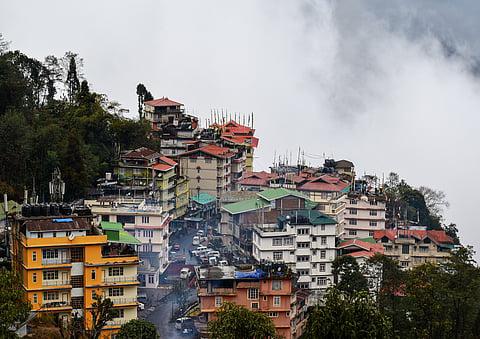
- Destinations
- Experiences
- Stay
- What's new
- Celebrating People
- Responsible Tourism
- CampaignsCampaigns
- Subscribe
- Buy Now

In a video that went viral recently, a vlogger is seen touring the roads of Sikkim, stumped by the cleanliness and orderliness of the state. “It feels like another country,” he is seen saying, comparing Sikkim's hygienic roads, lack of litter and clean public spaces to the other parts of India often marred by poor waste management. The video, which surfaced on various platforms, struck a chord with many viewers who were equally arrested by the eco-conscious that the state of Sikkim seemed to exhibit. The video, moreover, wasn’t a case of tricky filmmaking that deceives its viewers into seeing what isn’t there; it is owing to the state’s unswerving dedication to strict environmental practices and community-driven efforts rooted in sustainability that evoked such a reaction from the vloggers and his viewers. Here, we delve into the checks and balances of what makes the state earn its reputation for unmatched cleanliness.
Sikkim has long been a trailblazer in environmental regulation. It was in 1998 that the state turned into India’s first state to ban disposable plastic bags. This policy was far ahead of its time and paved the way for more comprehensive bans in the years that followed. Majority of the other states are still grappling with plastic ban and its effective implementation.
In 2022, the government took another landmark step by banning packaged drinking water in all government offices and events. This was preceded by a complete ban on Styrofoam and thermocol plates and cutlery in 2016. These decisions were made in response to the increasing volume of non-biodegradable waste entering Sikkim’s landfills and waterways.
According to the United Nations Environment Programme (UNEP), these policies have significantly curbed plastic usage in the state and have become a model for other regions to emulate.
One of the most impressive case studies within Sikkim is the town of Lachen, located about 129 km from the capital, Gangtok. It is observed from various news sources that already by 2011, Lachen witnessed a surge in plastic waste due to rising tourism. In response, the local governing body—called the Dzumsa—and the Lachen Tourism Development Committee imposed a ban on packaged drinking water.
By 2018, Lachen had also prohibited plastic carry bags entirely. Tourists are now provided with water through filtered sources at hotels and homestays, and instead of plastic bottles, bamboo bottles—sourced from neighbouring Assam—are used.
Over the years, Sikkim has leaned heavily into bamboo as an eco-friendly alternative to plastic. Supported by the National Bamboo Mission, the state promotes bamboo cultivation and artisanal industries. In the state you’ll encounter bamboo water bottles, cutlery, and packaging materials that have been increasingly adopted not only in Lachen but across other eco-tourism hubs in Sikkim.
This reliance on bamboo is not simply a modern policy but also rooted in the region’s traditional knowledge and conservation ethics. Local communities have long understood the importance of sustainable harvesting—only mature bamboo culms are cut, and careful attention is paid to regeneration cycles.
Sikkim’s bamboo economy not only provides green alternatives to plastic but also boosts rural livelihoods through cottage industries.
Sikkim’s achievements are not limited to plastic bans and bamboo products. Based on news sources, under the national Swachh Bharat Abhiyan, it was recognised as one of the cleanest state in India in 2016. Not only was it declared so in a sweeping judgement but four of its districts ranked among the top 10 nationwide in terms of sanitation.
That same year, Sikkim became one of the first Indian states to achieve 100 per cent open defecation-free (ODF) status. According to the Ministry of Drinking Water and Sanitation, 98.2 percent of households in Sikkim had access to sanitary toilets.
This culture of cleanliness is visible throughout the state—public dustbins are common, streets are regularly cleaned, and there’s visible enforcement of littering rules.
Sikkim’s eco-tourism framework is deeply interwoven with sustainability and public awareness. The state mandates green certification for tourism units under its Sikkim Eco-Tourism Policy 2011, which sets guidelines on waste management, energy use, and construction. Tour operators, guides, and over 700 registered homestays actively promote low-impact tourism by discouraging single-use plastics, enforcing waste segregation at source, and educating visitors on respecting fragile ecosystems.
Environmental education begins early—schools conduct regular nature camps and river clean-up drives, while state-run campaigns like Mero Gaon, Mero Swachh Gaon ("My Village, My Clean Village") mobilise communities across districts. Supported by NGOs and local panchayats, these initiatives ensure tourists and residents alike become stewards of the environment, not just passive participants.
What makes Sikkim stand out isn’t just its policies—it’s the statewide buy-in from its people. Whether it’s a rural villager in Lachen or a hotel owner in Gangtok, there's a shared understanding that sustainability is a collective responsibility.
This is what left the travel vlogger astounded—Sikkim didn’t look like the rest of India, not because it was foreign, but because it reflected what India could be with unified willpower and informed policy.
Sikkim, today, is more than just a tourist destination; it’s a blueprint for the future of sustainable development in India.
